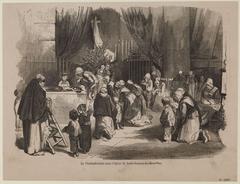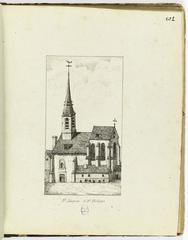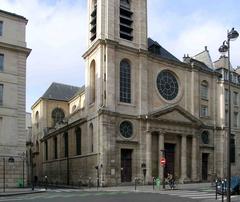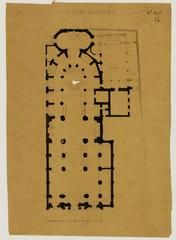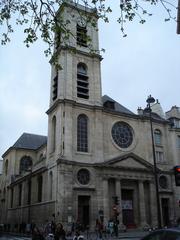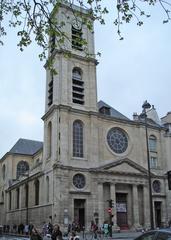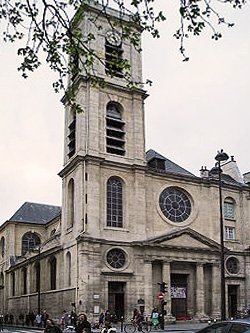
Église Saint-Jacques-du-Haut-Pas: Paris Historical Site Guide, Visiting Hours, and Tickets
Date: 15/06/2025
Introduction
Église Saint-Jacques-du-Haut-Pas, located in Paris’s historic 5th arrondissement, is a remarkable testament to the city’s layered religious, cultural, and architectural history. From its medieval origins as a hospital and place of hospitality for pilgrims on the Camino de Santiago, through its Renaissance transformation and role in the Jansenist intellectual movement, to its ongoing community impact, this church is both a spiritual landmark and a living monument of Parisian heritage. Whether you are a pilgrim, history enthusiast, or curious traveler, this guide will provide a comprehensive overview of the church’s history, architecture, visitor information, and practical tips for your visit.
For the latest updates on hours, tours, and events, always check the official parish website and heritage resources (Patrimoine-Histoire).
History and Significance
Medieval Origins and Pilgrimage Roots
Founded in 1180 by the Brothers Hospitallers of Saint-Jacques d’Altopascio, the original complex included a hospital and chapel serving pilgrims en route to Santiago de Compostela. The church’s name, “Haut-Pas,” is a French rendering of “Altopascio,” affirming its Tuscan roots and centuries-old association with pilgrimage (Patrimoine-Histoire). After the suppression of the order in 1459, the site’s charitable mission continued under subsequent religious communities.
Renaissance and Reformation
In 1572, Catherine de Médicis transformed the hospital into a Benedictine convent, deepening its monastic tradition. By 1620, the Oratorians, led by Pierre de Bérulle, established France’s first seminary here, reflecting the Catholic Reformation’s educational and spiritual ambitions. The construction of a new parish church in 1584 and later expansions under Gaston d’Orléans in 1630 signaled the church’s growing role within the Parisian religious landscape (Patrimoine-Histoire).
Architectural Expansion and Jansenist Influence
The 17th century saw significant architectural development, particularly under architect Daniel Gittard, who began construction of the current nave and the distinctive asymmetrical façade featuring a single tower, completed in 1684 (Monumentum). The church became a center for Jansenism, a reform movement emphasizing simplicity and spiritual rigor, and was closely associated with Port-Royal-des-Champs. The burial of Jean Duvergier de Hauranne, abbé de Saint-Cyran, in the choir in 1643, underscored its theological significance.
Revolution, Restoration, and Artistic Heritage
During the French Revolution, the church was desecrated and repurposed as the “Temple de la Bienfaisance.” Catholic worship resumed in the 19th century, which also brought new artistic contributions such as frescoes by Auguste-Barthélemy Glaize and paintings by notable artists, establishing the church’s reputation for both spiritual depth and artistic quality (POP).
Modern Community Life
Today, Saint-Jacques-du-Haut-Pas remains an active parish, continuing its tradition of hospitality, catechesis, and social outreach. The legacy of Jean-Denis Cochin, who founded the hospice that became Hôpital Cochin, is commemorated here (Diocèse de Paris).
Architectural Features
Exterior
- Location: 252 rue Saint-Jacques, Latin Quarter.
- Design: The westward-facing choir and asymmetrical façade, with a single, towering spire, reflect 17th-century architectural choices and Jansenist values of restraint.
- Facade: Built from Parisian limestone, the façade combines classical columns and a single tall bell tower, originally intended to be one of two.
- Materials: The exterior is intentionally plain, with subtle Gothic elements such as buttresses and rose windows, and minimal sculptural detail.
Interior
- Nave and Plan: The elongated nave, about 60 meters long, features a Latin cross plan with a single nave, side aisles, and multiple chapels. Rounded arches and robust pillars provide a sense of solemnity.
- Light: Large, clear-glass windows flood the church with natural light, in keeping with Jansenist ideals of spiritual clarity and focus.
- Chapels: The Chapel of the Virgin (by Libéral Bruant, redecorated in 1868 by Glaize) and the Saint-Pierre Chapel (1835) are artistic highlights.
- Organ: The church’s organ includes a 16th-century wooden case—one of Paris’s oldest—restored in 1971 (POP).
- Artworks: Paintings by Humbert, Jeurat, Legendre, Calvaert, Bourdon, Lesueur, and others enrich the spiritual atmosphere.
Community, Liturgy, and Pilgrimage
- Active Parish: Regular Masses, confessions, adoration, prayer groups, and catechism are offered (Diocèse de Paris).
- Social Outreach: The parish maintains a strong tradition of charity, supporting families and the vulnerable.
- Camino de Santiago: The church remains a stop for pilgrims, with art and features dedicated to Saint James the Less (Patrimoine-Histoire).
- Heritage Protection: Listed as a Monument Historique since 2017 (POP).
Visitor Information
Opening Hours
- Monday to Friday: 9:00 AM – 7:00 PM
- Saturday & Sunday: 9:00 AM – 6:30 PM
Hours may vary during holidays and special events. Always check the parish website or Diocèse de Paris for the latest details.
Admission and Tickets
- Entry: Free of charge.
- Guided Tours: Available by appointment and during special events such as Heritage Days. Free audio guides (French) are available for mobile phone users (Diocèse de Paris).
Accessibility
- Physical Access: The main entrance is at street level and wheelchair accessible; ramps are available.
- Facilities: No public restrooms inside; nearby cafés offer facilities.
Getting There
- Address: 252 rue Saint-Jacques, 75005 Paris, France
- RER B: Luxembourg station nearby
- Metro: Censier-Daubenton (Line 7), Port-Royal (RER B)
- Bus: Lines 21, 27, 38, 82, 84, 85, 89
Visitor Etiquette
- Modest attire required; hats off, shoulders and knees covered.
- Maintain silence during services; be respectful of private prayer.
- Photography permitted without flash; avoid use during services.
Highlights for Visitors
- Artworks: Notable paintings by Jean Restout, François Gérard, Le Nain brothers, and Auguste Glaize (Diocèse de Paris).
- Modern Liturgical Furnishings: Works by Léon Zack signal post-Vatican II renewal.
- Organs: Historic grand and choir organs, including Cavaillé-Coll craftsmanship.
- Chapel of the Virgin: Renowned for its decoration and Marian art.
- Events: Concerts, lectures, and community activities detailed on the parish website.
FAQ
Q: What are the visiting hours?
A: Monday to Friday 9:00–19:00, Saturday and Sunday 9:00–18:30 (confirm on the official website before your visit).
Q: Is there an entry fee?
A: No, entry is free.
Q: Are guided tours available?
A: Yes, by appointment or during special events. Free audio guides are available.
Q: Is the church wheelchair accessible?
A: Yes, the main entrance is accessible.
Q: Can I take photographs?
A: Yes, without flash and always respectfully.
Q: Are there nearby attractions?
A: Yes, Jardin du Luxembourg, Panthéon, Sorbonne, and the Latin Quarter are all within walking distance.
Practical Tips
- Best Times: Early mornings and late afternoons are quieter.
- Combine Your Visit: Explore nearby cultural sites for a full Latin Quarter experience.
- Safety: The area is safe, but always watch your belongings.
- Language: Most materials are French; some staff speak English.
Plan Your Visit
Make the most of your trip by reviewing the latest schedules and event listings on the parish website, and consider downloading the Audiala app for audio tours and travel tips. For additional insights and virtual experiences, explore online resources and high-quality images of the church’s art and architecture.
Sources
- Patrimoine-Histoire
- Monumentum
- Diocèse de Paris
- POP: Plateforme ouverte du patrimoine
- Official Parish Website
By following this guide, your visit to Église Saint-Jacques-du-Haut-Pas will be both enriching and memorable, offering a window into the spiritual, artistic, and communal heart of Paris.

